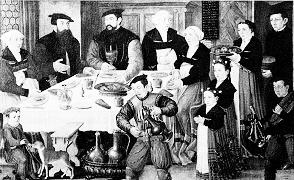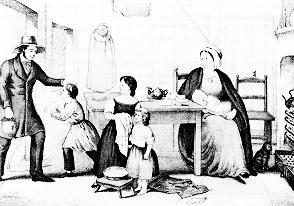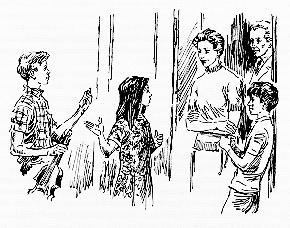|
|
|||||||||
|
|
THE TRADITIONAL EXTENDED FAMILY
Swiss middle-class family in 1559. Although painted more than 20 years after the death of Erasmus, the picture still shows the typical family for which he wrote his Colloquia Familiaria. Note the presence of various relatives and several generations under one roof and the demeanor of the children who are portrayed as serious-minded miniature adults, especially the little boy with the dog at bottom left.
American middle-class family in the 19th century. The picture shows the "ideal" new nuclear family as it emerged with the Industrial Revolution. The father, a wage earner who works outside the house, is returning home to the warm welcome of his children who have not seen him all day. The mother, who is nursing another baby, is occupied with childcare and other domestic concerns. The household no longer includes grandparents or other relatives.
"Typical"American Family in the 20tK century. In our own time, the nuclear family with its own suburban home has come to beseen as the only valid model. For several decades now its image has been appearing on countless billboards, in advertisements, commercials, films, radio- and tv-shows as welI as in school books. Our picture is taken from a 1972 children's book, Baney's Lake. Thus, with increased economic opportunity, some nuclear families might expand, become rich, and gain social influence. Or, when faced with some financial threat, they might contract again, consolidating their holdings. By the same token, however, the poor masses in most of medieval Europe could never aspire to the protected life in a big family household. Instead, they lived in very small groups in separate huts or hovels. Obviously, large farm houses, mansions, palazzos, and castles were reserved for the affluent. Nevertheless, with the beginning of the Modern Age and the growth of commerce, there developed a middle class which could afford to build big, convenient living quarters. Thus, in the cities the modest one- or two-room dwellings of the poor began to be overshadowed by well-made houses, several stories high, in which wealthy officials, merchants, and craftsmen lived with their wives, children, parents, friends, servants, clerks, and apprentices. These "big houses" provided the space for what is now often seen as the ideal extended family or, as it has also been called, "the classical family of Western nostalgia". Such a family certainly had its advantages. People knew where they belonged and what was expected of them. They ate, drank, slept, learned, worked, and played together under the same roof. From birth to death they were part of an organic whole, growing up and growing old among familiar faces. They all served the common good and shared every joy and every grief with each other. When they were weak, they found ready support, when they were sick or disabled, they found care and protection. In short, they were never lonely, and their lives always "made sense". It is this feeling of reassurance, this sense of security, which now makes the extended family seem so attractive. However, as historical studies have shown, all that "togetherness" did not really provide much emotional warmth. The main function of the big household was economic. Affection and tenderness were of secondary importance. Not much attention was paid to individual needs and concerns. After all, the parents themselves usually had not married for love, but for material, practical reasons. Furthermore, the wife's status was lower than that of her husband whose wishes always prevailed. Very often there was also a great age difference between the spouses, because many women died in childbirth, and men tended to remarry younger partners. Or, when the master of the house died, his widow married his first assistant in order to keep the business together. A few children were welcome as potential workers, but their parents spent little time with them. Instead, they were brought up by servants and soon sent away as apprentices. Sons of noblemen became pages with other noble families. Many children were simply neglected, and infant mortality was high. For example, in early 18th century London the odds were still 3 to 1 against a child reaching the age of five. Under the circumstances, parents did not become too closely attached to their offspring. Indeed, direct and indirect infanticide was practiced widely. Parents simply let their children suffocate in bed or gave them away to nurses or foster mothers who were known to starve or kill them outright. Even the "enlightened" Jean-Jacques Rousseau, who wrote so sensitively about the innocence of childhood, put his own five children in an orphanage. In these institutions, which provided a welcome supply of domestics and soldiers, the mortality rate was often 80-90%. We also have to realize that, before the late 17th and early 18th centuries, the "big houses" were, as a rule, noisy and overcrowded. They offered no privacy, but rather were semipublic places. People ran in and out of all rooms at all hours of the day. Visitors appeared unannounced, friends, acquaintances, business partners, clients, solicitors of all kinds walked freely about and sometimes stayed overnight. In addition to its various servants, the household itself usually also contained several permanent guests. There was no formal division between private chamber, workshop, or office. Beds and tables were set up and moved according to need. There were no regular "family dinners", no fixed mealtimes, and many meals were improvised, catered, or bought from the innkeeper next door. A "family life" as such did not exist. Instead, all activities were part of a larger social life. The family was always open to the community and its influences. It is therefore hardly surprising that, among the middle and upper classes, the relationships between family members were rather formal and cool. In France, husband and wife addressed each other as "Monsieur" and "Madame", in England as "Sir" and "Madam". These official-sounding titles were also used when children spoke to their parents. Noble children called their parents "Milord" and "Milady". Among themselves, the children were no less ceremonious. Instead of using first names, they called each other "brother", "sister", and "cousin". The use of first names, nicknames, and the intimate "Papa" and "Mamma" did not become fashionable until the late 17th century. (After 1800 the English changed their spelling to "Mama", while the Americans used "momma" and later spoke simply of "Mom" and "Dad".) Obviously, then, for centuries the members of the large European household did not feel much sentimental concern for each other. True, intimacy and emotional closeness developed only with the gradual consolidation of the middle class and the growing influence of middle-class values. As the solid citizen prospered, he became ever more industrious, orderly, respectable, disciplined, and domestic; in short, he turned into the now familiar figure of the "bourgeois". This process was well under way by the late 1600's and accelerated through the following century. The "big house" itself began to change. Where once there had been interconnected, open all-purpose rooms, there were now separate, closed chambers for dining, sleeping, reading, and music making. Servants were banned to special quarters "downstairs" or under the roof. Spheres of privacy were established. Business and pleasure were no longer mixed. Workroom and living room became clearly separated. Each house had an "inner sanctum" which was no longer accessible to casual visitors. Indeed, unannounced visits were discouraged. The family "received" only on certain days or "jours fixes". At all other times, the family members cultivated each other's company. They gathered around the "family table", played "family games", read "family magazines", and gave "family concerts". Parents took the most tender interest in the welfare and education of their children, who were now regarded as "pure", help-less creatures in need of protection. This protection was found in the family circle. The new ideal was the sheltered, warm, sweet, and idyllic "happy home".
FAMILY LIFE IN THE 17TH CENTURY
FAMILY LIFE IN THE 19TH CENTURY Needless to say, this ideal, which emerged only slowly, was by no means realized everywhere. Both the upper and lower social classes lived very differently. The aristocrats continued much as before in open castles or palaces, surrounded by a tumultuous host of relatives, supplicants, servants, and guests. The poor farmers and common laborers, on the other hand, still lived alone with their wives and children in small, cramped houses, huts, or cabins. As a matter of fact, the bourgeoisie itself often deviated from its own standards as it became more mobile and adventurous. Many men did not care very much for all those quiet evenings with their loved ones. Therefore, they turned the house into a "woman's world" and developed a regular social life of their own in cafes, pubs, guilds, lodges, associations, fraternities, and clubs. As a result, the function and form of the family changed again. It also became clear that the tendency toward family "closeness" was, in effect, a tendency toward reduction in family size. The continued presence of the older generation and of distant relatives was increasingly seen as intrusive. Thus, with the beginning industrialization, the traditional extended family itself gave way to the modern nuclear family. |





